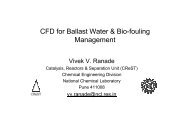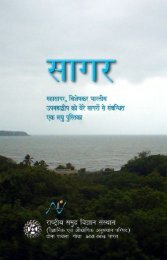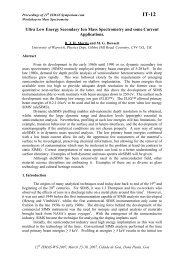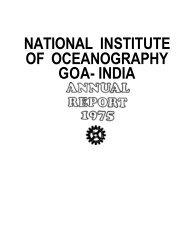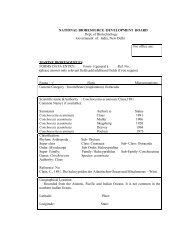1980 - National Institute of Oceanography
1980 - National Institute of Oceanography
1980 - National Institute of Oceanography
You also want an ePaper? Increase the reach of your titles
YUMPU automatically turns print PDFs into web optimized ePapers that Google loves.
2. the integral mean concentration <strong>of</strong> the nutrients in the surface mixed layer<br />
is in agreement with the near-surface circulation. The high value <strong>of</strong> nutrients associated<br />
with low dissolved oxygen are confined to thicker surface layers indicating<br />
clearly the effect <strong>of</strong> divergence or cyclonic gyre (convergence or anticyclone gyre)<br />
present in the near-surface circulation.<br />
3. the salinity structure shows that the Bay <strong>of</strong> Bengal has estuarine type <strong>of</strong><br />
circulation due to heavy discharge <strong>of</strong> fresh water all along its land peripheries.<br />
(c) ΜΟΝΕΧ-79 studies<br />
The hydrographic and MBT data collected during MONEX-79 programme<br />
were processed. For the analysis <strong>of</strong> these data, the following computer programmes<br />
were developed: (i) Bionomial filter programme for smoothening the digitized data,<br />
(ii) A programme for computing the potential energy <strong>of</strong> the water column and the<br />
energy changes due to mixing and (iii) A programme for analysing the wave<br />
records.<br />
The study revealed significant variations in the upper 500 m during the period<br />
May to June 1979. The sea surface temperature increases by about 1°C whereas<br />
the thickness <strong>of</strong> the mixed surface layer decreases by about 10 m. Inspite <strong>of</strong> the<br />
above features, the cyclone heat potential showed an increase from May to June<br />
1979 in the MONEX square (the region from where the data were collected). The<br />
heat potential was estimated to be about 30 kcal/cm 2 which can maintain a moderate<br />
cyclone for a period <strong>of</strong> 6 days. The rise in thermocline is attributed to the entrainment<br />
<strong>of</strong> cool subsurface water into the surface layer. Further studies to prove<br />
this are being carried out using the continuity equation. The influence <strong>of</strong> equatorial<br />
watermass in the MONEX area is clearly seen during May-June 1979.<br />
Preliminary studies on the thermodynamic potential <strong>of</strong> seawater indicated that the<br />
changes in energy associated with contraction or mixing are important for understanding<br />
the watermass structure in the MONEX square.<br />
(d) Heat budget <strong>of</strong> the Andaman Sea<br />
The seasonal heat storage including the fluxes <strong>of</strong> net radiation, latent and sensible<br />
heat have been worked out for the Andaman Sea. These studies indicated an<br />
annual evaporation rate <strong>of</strong> about 137 cm over the region <strong>of</strong> the Andaman Sea and the<br />
vertical heat transport is confined to the upper 20 m where a strong halocline exists<br />
which probably inhibits the heat transfer to deeper waters.<br />
3.1.2 Studies on physical processes in the seas around India<br />
Field data were collected during 7 cruises from the Bay <strong>of</strong> Bengal including<br />
the Andaman Sea and the eastern Arabian Sea. During two <strong>of</strong> these cruises (viz-<br />
69th and 75th) observations were carried out in the MONEX square for studying<br />
the post-monsoon conditions. CSTD System was operated and continuous pr<strong>of</strong>iles<br />
21



